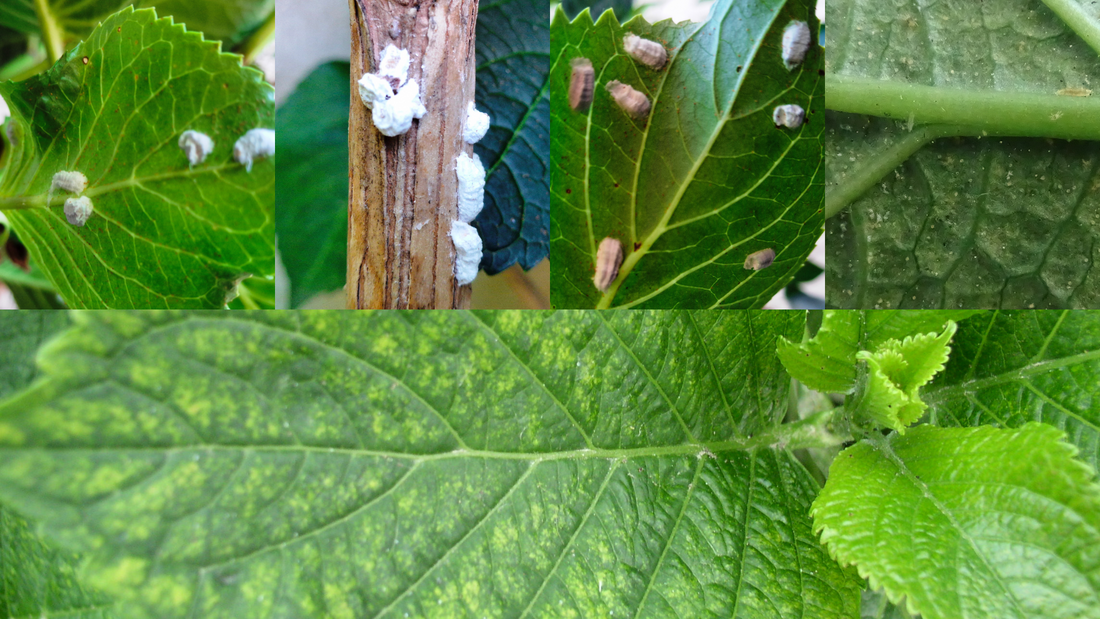Diseases & Care of Hydrangeas – Causes & Solutions
Hydrangeas delight us with their lush blooms, but sometimes the panicles and balls fail to appear, or the leaves show signs of deficiency or infestation. In this article, you'll learn how to avoid common mistakes in pruning, winter protection, fertilization, and site selection, as well as how to identify pests and diseases and address them with targeted measures.
1. Lack of flowering in hydrangeas
Cause: Incorrect pruning and winter damage
- Pruning mistakes: Hydrangea macrophylla (garden hydrangea) blooms on the previous year's wood . Never prune heavily in fall or spring – simply pinch off the faded panicles. More on proper hydrangea pruning .
- Winter damage: If the flower buds formed in the fall are not protected, they will freeze to death in frost. Read our tips on overwintering hydrangeas .
2. Yellow leaves – nutrient deficiency & pH problem
Symptoms: Yellowed leaves, especially leaf veins remain green (chlorosis).
Causes & Solutions:
- Alkaline soil (pH > 7.0): Iron and other micronutrients precipitate. Lower the pH by adding rhododendron/peat soil or pine bark mulch.
- Iron deficiency: Fertilize with iron-rich special fertilizers or use our Ullmann Hydrangea Fertilizer , which also contains chelated iron.
- Nutrient imbalance: Avoid excessive nitrogen application in late summer (no nitrogen fertilizer after mid-August) to allow the plant to mature and develop frost resistance. Learn more about optimal hydrangea fertilization .
3. Animal pests – aphids, whitefly, mealybugs, spider mites & thrips
Signs: Stunted shoots, fine webs (spider mites), silvery discoloration.
Prevention & Control:
- Balanced nutrition: Too much nitrogen leads to weak shoots, which attract aphids and thrips. Follow our care and fertilization tips .
- Location: Spider mites love heat and dry conditions. Water in the morning and evening and increase humidity by misting.
- Biological pesticides: In case of severe infestation, treat in a way that protects beneficial insects (e.g. neem oil, Substral Naturen Pest-Free, nettle decoction).
Spider mites (Tetranychidae)

Spider mites prefer to settle in environments that are too dry and too warm.
Recognition:
- Spider mites are first identified on the underside of leaves
- In the second step, they damage the leaves through their sucking activity (see picture)
- Next, small cobweb nests emerge
- In the end, the whole leaf is covered with cobwebs and the plant dies
Size of the spider mite:
Size: 0.25 mm – 1 mm
Reproduction:
Spider mites reproduce by laying eggs from which new spider mites hatch.
Combating:
- To begin with, a typical household remedy helps: rapeseed oil-water mixture
- Mix 4 parts water and 1 part rapeseed oil well
- Spray the undersides of the leaves completely (weekly)
- Fresh predatory mites or gall midges from specialist retailers are also helpful
- A female gall midge eats up to 30 spider mite eggs per day
- The existing spider mites should then be removed
- Rinse gently but precisely with a jet of water
Prevention:
- Pay attention to proper care, a suitable climate and healthy plants
- Ensure high humidity in dry conditions
- Proper fertilization with Ullmann Hydrangea Fertilizer is essential

4. Fungal diseases – mildew & grey mold
Fungal infestation occurs mainly in humid, windless weather and with poor air circulation.
-
Powdery mildew (Erysiphaceae):
A white, powdery coating on the upper and lower surfaces of leaves and shoot tips is caused by an overly humid microclimate.
Measures:
- Remove diseased leaves and discard.
- Fungicide spraying with approved products
- Ventilate the site and avoid close planting distances.
-
Gray mold (Botrytis cinerea):
A gray, downy coating on buds, flowers, and leaves. Common in cool, moist wintering areas.
Measures:
- Remove infested material completely.
- Apply fungicide preventively.
- Overwinter in a well-ventilated place at 2–5 °C, keeping an eye on soil and air humidity.
5. Summary & further links
With proper pruning, appropriate winter protection, balanced fertilization, and targeted pest and fungal control, your hydrangeas will remain healthy and blooming. Take advantage of our internal resources:
- Correct hydrangea pruning
- Tips for overwintering
- Biological plant protection
- Optimal fertilization strategies
We wish you much success and a green thumb
Your team at Hydrangea World Ullmann

